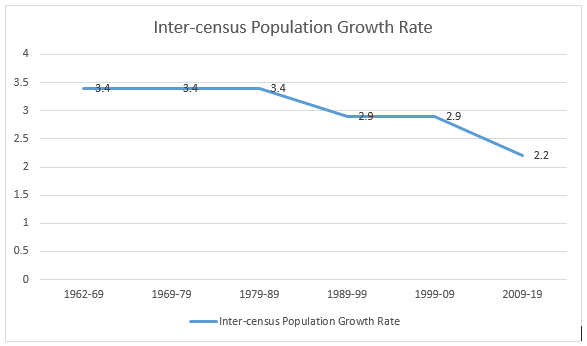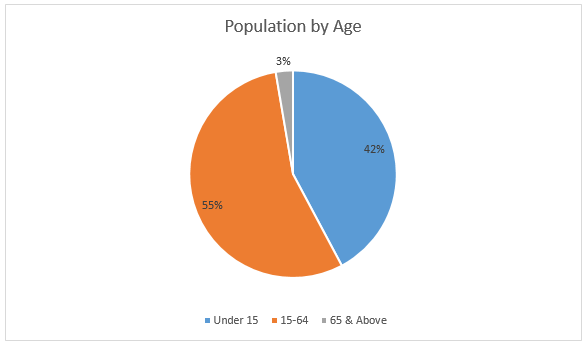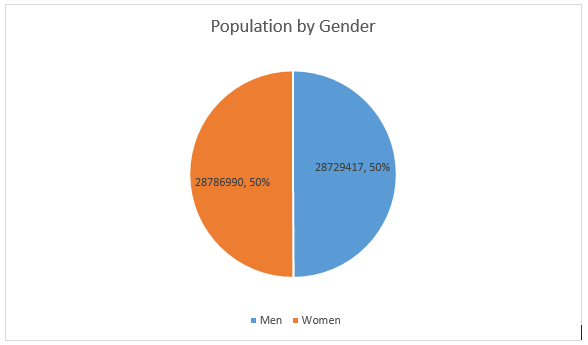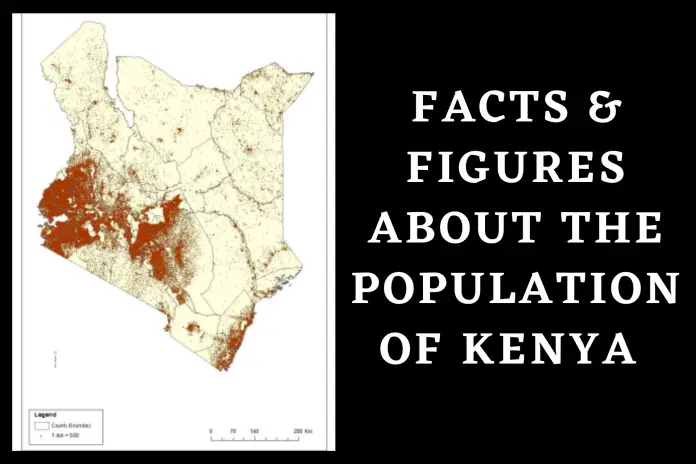Key Takeaways
- Kenya’s median age is 20.1
- Kenya’s population increases by about 2.20 % yearly
- The current life expectancy for Kenya in 2023 is 69.69 years
- The fertility rate for Kenya in 2023 is 3.259 births per woman
- There are two official languages in Kenya: English and Swahili
- As of June 2023, Kenya’s estimated population is 57,516,693 million
Kenya, located in East Africa, is a vibrant and diverse country known for its stunning landscapes, rich cultural heritage, and thriving wildlife. Kenya is one of Africa’s most populous countries with a population that continues to grow steadily. This article will delve into the facts and figures surrounding Kenya’s population and demographics, exploring its ethnic diversity, urbanization, and other key demographic indicators.
Total Population
As of 2023, Kenya has an estimated population of 55 million, equal to 0.69% of the world’s population. Kenya’s total land area is 569,140 Km2.
Population Growth Rate

Kenya’s population has been increasing by about 2.20% yearly. This percentage is equal to over a million people annually. This steady increase can be attributed to a combination of factors, including high fertility rates and improved healthcare, leading to lower mortality rates.
Age Distribution
Kenya’s median age is 20.1. Approximately 75% of the population is between 18-35 years. The age distribution is as follows:
- 24,274,800 young people under 15 years old (12,226,838 males / 12,047,962 females)
- 31,697,867 persons between 15 and 64 years old (15,928,594 males / 15,769,273 females)
- 1,543,740 persons above 64 years old (696,524 males / 847,217 females)

Kenyan population has an expanding pyramid type. It is common in developing nations with high birth and death rates.
Urban vs. Rural Population
Kenya has an urban population of about 14.97 million, a percentage of 31.1%. Nairobi, the capital city, has the highest population at 4.397 million. The others are Mombasa with 1.208 million, Nakuru with 570,674, Kisumu at 440, 891, and Eldoret with 475, 716.
Most of the urban population is between 20 and 34, both sexes. Additionally, there has been a growth of satellite towns around Nairobi. These are Ruiru, with a population of 490,120, Ongata Rongai 172,569, Juja 156,041 and Kitengela 154,436. Kenya’s rural population is 71.51%
Population Density
Kenya’s population density is 94 per Km2, 245 people per mi2. Kibera is the densest place in Kenya with around 70,000 people per square kilometre. This makes the slum the densest in Africa and the second-largest globally.
Nairobi and Mombasa have a population density of over 5000 per square kilometre. Apart from Vihiga, all the other counties have a density of less than 1000 per square kilometre.
Marsabit has the sparsest population, with a density of 6 people per square kilometre. Tana River County follows closely with a population density of 8 people/ Km2. The low population in these regions can be attributed to adverse climatic conditions.
Ethnic Groups and Diversity
Kenya has a diverse population with different cultures comprised of various ethnic and racial groups. These are the Bantus, Nilotes, Cushites, Indians, Arabs, and Europeans.
The largest ethnic group is the Kikuyu, a Bantu community. They comprise about a fifth of the population, followed by the Luhya, Kalenjin, and Luos.
The Top 10 Largest Tribes in Kenya (2019 Census)
| Tribe | Population |
| Kikuyu | 8,148,668 |
| Luhya | 6,823,842 |
| Kalenjin | 6,358,113 |
| Luo | 5,066,966 |
| Kamba | 4,663,910 |
| Somali | 2,780,502 |
| Kisii | 2,703,235 |
| Mijikenda | 2,488,691 |
| Meru | 1,975,869 |
| Maasai | 1,189,522 |
Bantu communities include Kikuyu, Kamba, Kisii, Meru, and the Mijikenda, making up Kenya’s largest population division.
The second grouping is the Nilotes. They comprise the Luo, Maasai, Samburu, Kalenjin and Turkana. They have a similar governing structure to their Cushite neighbours.
The third-largest group is the Cushite, who came from Ethiopia and Somalia. They are subdivided into Southern and Eastern Cushites. The Southern Cushites, in their migration, wound up in Tanzania, which leaves on Eastern Cushites in Kenya. They include the Oromo and the Somali. The Somalis are an entrepreneurial community and have established themselves in the business sector.
Apart from those three groups, Kenya has many Asians living here. According to the census, there are about 47,555 Indians in the country, and in 2017 were recognized as the 44th Kenyan tribe. Kenya also has many European settlers, primarily the British, who are descendants of the migrants in the colonial period. The country also has a large expat community.
Finally, there is a small Arab community in Kenya located in the coastal region. They are a Muslim community from Yemen, Oman, and Hadhramut.
Languages Spoken
There are two official languages in Kenya which are English and Swahili. However, Swahili is more widely spoken compared to English. It is a language native to East Africa, locally known as Kiswahili. It is a Bantu language with borrowed words from Arabic, English, German, and Persian.
Migration Patterns
Kenya loses about 10,000 people annually to external migration, with 12,887 people in 2022. However, the country experiences more internal migration. The coastal region has experienced the highest migration percentage at 59.5% in urban areas.
There’s also a lot of rural-urban migration, which has increased the urban population to about 14,975,059. Males predominantly outnumber females in rural-to-urban migration driven by the desire for better education and economic opportunities.
The country has also experienced increased international immigrants seeking to set up businesses or settle there. There are also irregular border movements that are hard to control which has seen an increase in undocumented foreigners.
Fertility Rate
In many countries, the fertility rate has steadily reduced in recent decades. Factors such as the age at which women have a first child and marriage have hugely affected the fertility rate.
Over the last few years, Kenya’s fertility has declined by about 1.55%. Currently, the fertility rate for Kenya in 2023 is 3.259 births per woman, a 1.57% decline from 2022.
Life Expectancy
Life expectancy at birth is a crucial demographic indicator. This data shows the number of years an infant is expected to live if the birth and death rates remain constant during their lifetime.
Kenya’s life expectancy has been increasing over the years. The current life expectancy for Kenya in 2023 is 69.69 years, with 67.98 years for males and 71.43 years for females.
Gender Distribution
Kenya’s population as of January 2023 stood at around 55 million people. Contrary to the popular belief that the ratio of men to women in Kenya is 1:7, the population is almost the same. The population sex ratio is 0.998, meaning 998 males per 1000 females.
This ratio is lower than the current global ratio of approximately 1,016 males to 1,000 females as of 2022. However, gender inequality in public offices is still prevalent.

Household Income Distribution
Though Kenya has the fastest number of growing super-rich in the region, there is still a huge income disparity. Currently, the average monthly income for households is Sh20,123. This figure is an increase from 2021’s average monthly income of sh. 18,028, according to the Kenya National Bureau of Statistics (KNBS).
However, the gap between Kenya’s rich and poor is still high. Less than 0.1% of the population own more wealth than the bottom 99.9%. The best employers in Kenya are International NGOs and financial sectors in the formal environment, with lowest paying jobs being in the household sectors.
This sector employs domestic workers. Other low earners include those in the real estate, water supply, and waste management sectors. The agricultural industry is also one of the largest employers, and workers earn an average of Sh. 31,469 per month.






















